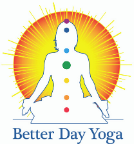
Warrior I (Sanskrit terms: Virabhadrasana I)
The three forms of Warrior (Virabhadrasana) are named after a powerful, auspicious warrior, Virabhadra, from Hindu history. When you perform one of the warrior poses, feel the strength of this pose and imagine yourself capable of anything that needs to be accomplished — because you are! “Think of the strength, balance, and nobility of a warrior. Feel the power as your hands stretch up to the sun and your feet root to the earth.” The new guide to relaxation, Pilates, yoga, meditation, stress relief, Paragon Publishing. This pose helps you realize that no matter what you facing in your personal life, at your core you are balanced and strong.
“The warrior is an empowered person with a definitive sense of selfhood. Warriors know who they are in themselves and in relation to the world. Their sense of self is neither inflated nor weak. They have the inner strength and resilience to see their dreams materialize into reality and the stamina to meet physical and emotional challenges.” The Book of Chakras, Ambika Wauters. This is a quote from the Solar Plexus chakra section as the positive archetype for this chakra—one of the two chakras I focus on in my Chakrascope below.
From Mountain Pose, step the right leg back, aligning the heels. Turn your back toes to angle slightly forward making your back heel the furthest part away from your body. Bend the left knee to 90 degrees and reach the arms actively overhead, keeping them parallel, with palms facing in and elbows lining up with the ears. Keep your elbows straight activating dynamic tension in the upraised arms and hands, stretching from your elbows to your fingertips. Relax your shoulders down and back away from the ears, firming your shoulder blades to the back. Your tailbone points down and your spine is long.
Your gaze is straight ahead. (There are some who instruct looking up toward the hands, as well as bringing the hands together. This places unnecessary tension on the neck and shoulder joints, respectively; and the upward gaze can misalign the vertebrae in the neck.)
Make sure your front knee stacks directly over the ankle, and not beyond, making your shin perpendicular to the ground. Your right thigh should come no lower than parallel to the ground. Your waist is lifting up off the hips. Focus on keeping your arms and upper torso lifting towards the ceiling, engaging your abdominals, while your bottom torso and legs ground down into the floor. Both feet are pressed evenly into the floor.
Square your hips and shoulders lining them with the front edge of the mat. Keep the back leg straight by pressing the back foot strongly into the floor and sink into your forward leg. A strong warrior will be just as exhausting on the back leg as the front leg, Photo #1.
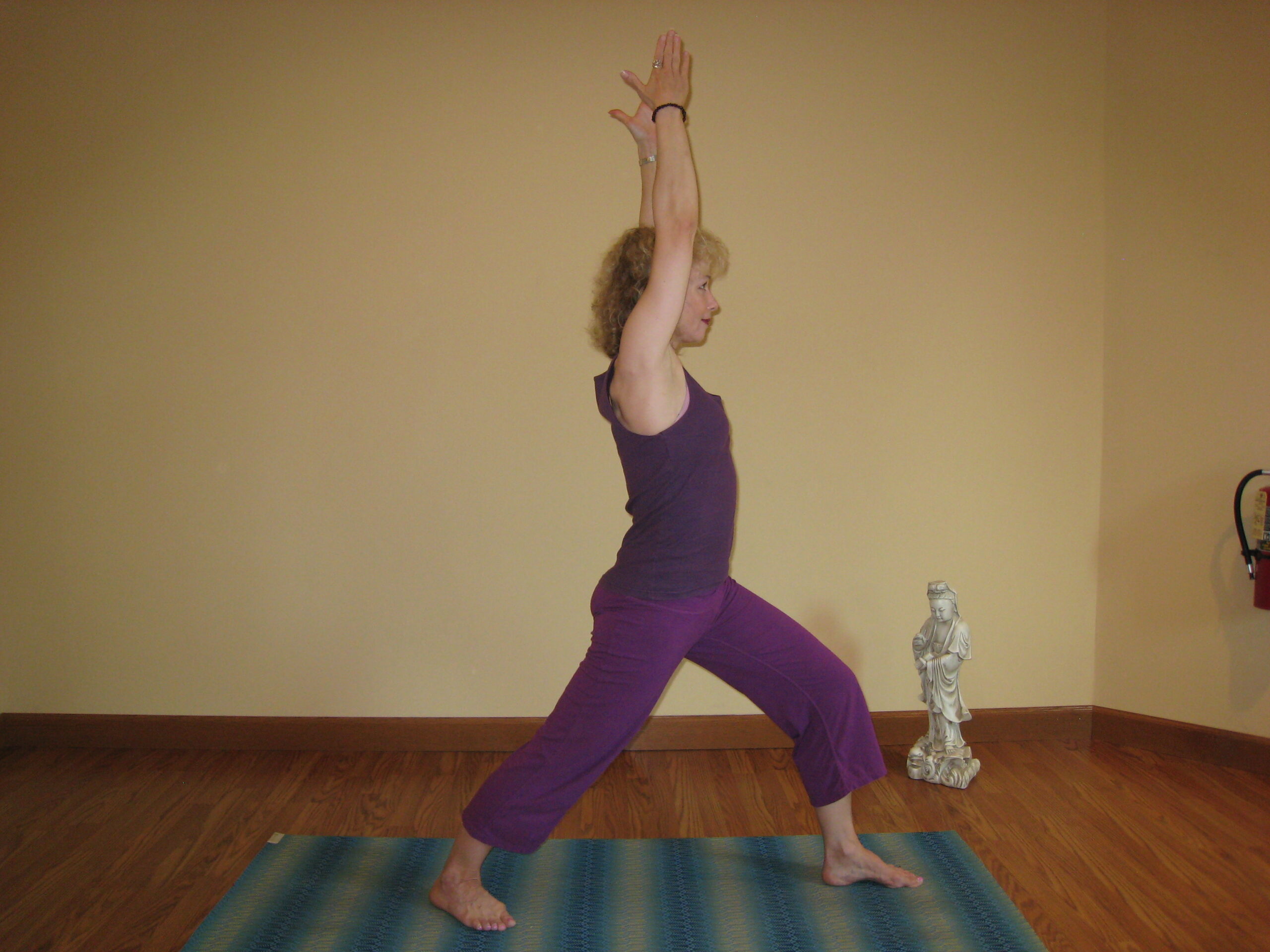
There are several schools of thought on foot placement:
Aligning the heels helps to square the hips forward and adds a stretch to the back hip flexor. This is the most common cue I’ve seen, and it’s how I was taught, so it’s how I cued it above.
Stepping directly back keeping the legs spaced left to right hip distance apart allows for the greatest ease of comfort in the low back, as well as aids in balance, (not pictured). When I am going to do the Waterfall Warrior flow, highlighted in the advanced pose flows below, I instruct to widen the hips a little more than usual left to right to allow for extra balance as we add a flow to the pose.
Aligning front heel to the inner arch of the back foot is another foot placement possibility. This opens the hips a bit more. http://yoga.about.com/od/yogaposes/a/warrior1.htm. Photo #2.
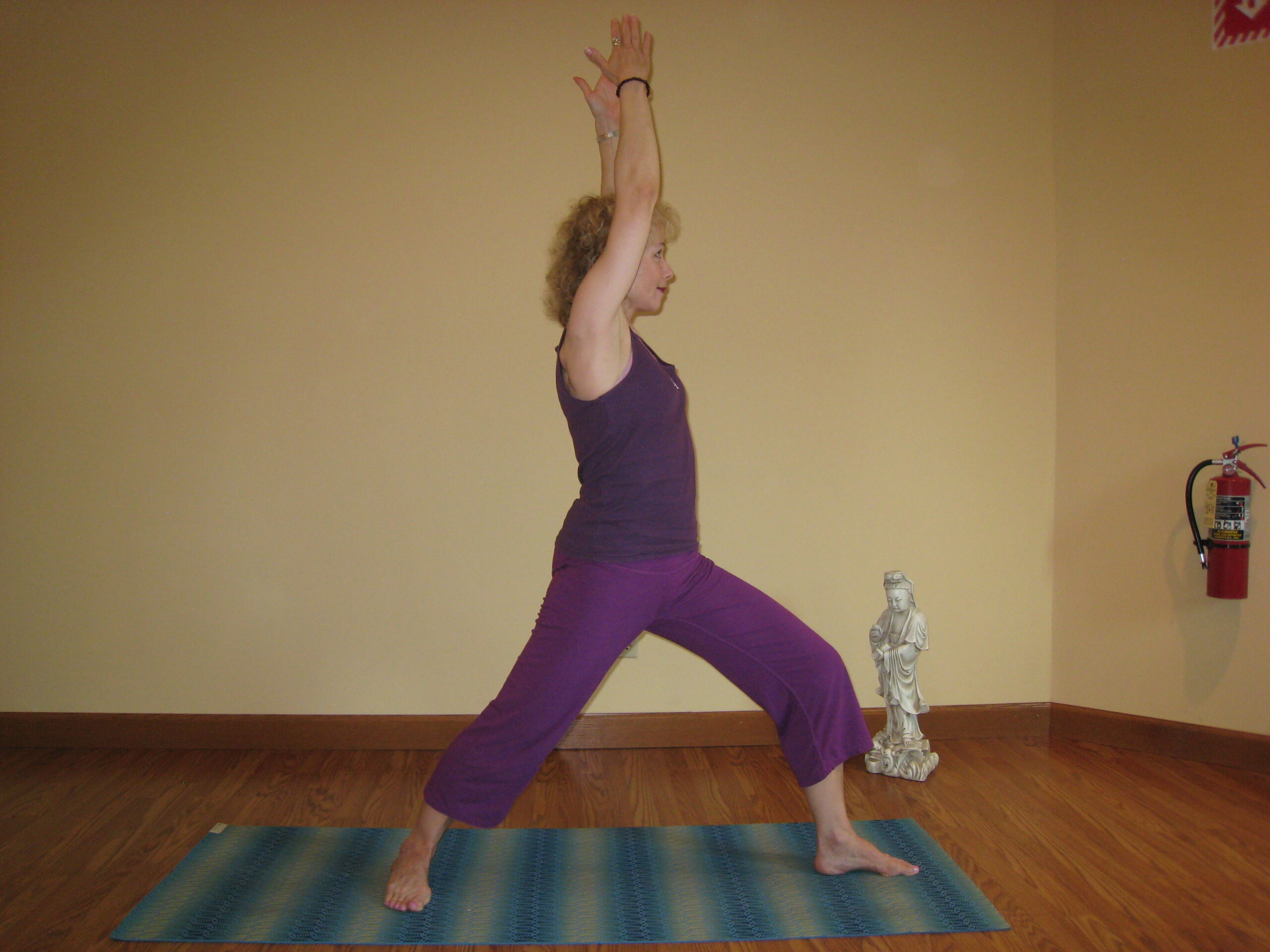
You can also come into this pose by stepping forward from mountain pose. See the advanced options for another, more challenging way to come into this pose.
Benefits:
- Strengthens the legs, upper back, and shoulders
- Opens the hips and chest
- Stretches the arms, hip flexors, hip adductors, and calves
- Develops concentration, balance and groundedness
- Improves circulation and respiration and energizes the entire body
- Relieves joint stiffness
- Tones the abdominal muscles
Beginner’s tip: Still unsure on your form or new to yoga? You can try a practice pose.
Arms: Bring the arms to the front thigh, Photo #3 or bring the hands to heart center in Namasté position, if you are taking care of your shoulders or to lessen the intensity of the upper body, Photo #4. If your shoulders don’t have the range of motion to bring the elbows in line with the ears when the arms are raised to the sky, try cactus arm position Photo #5, keeping the hands back in line with the shoulders.
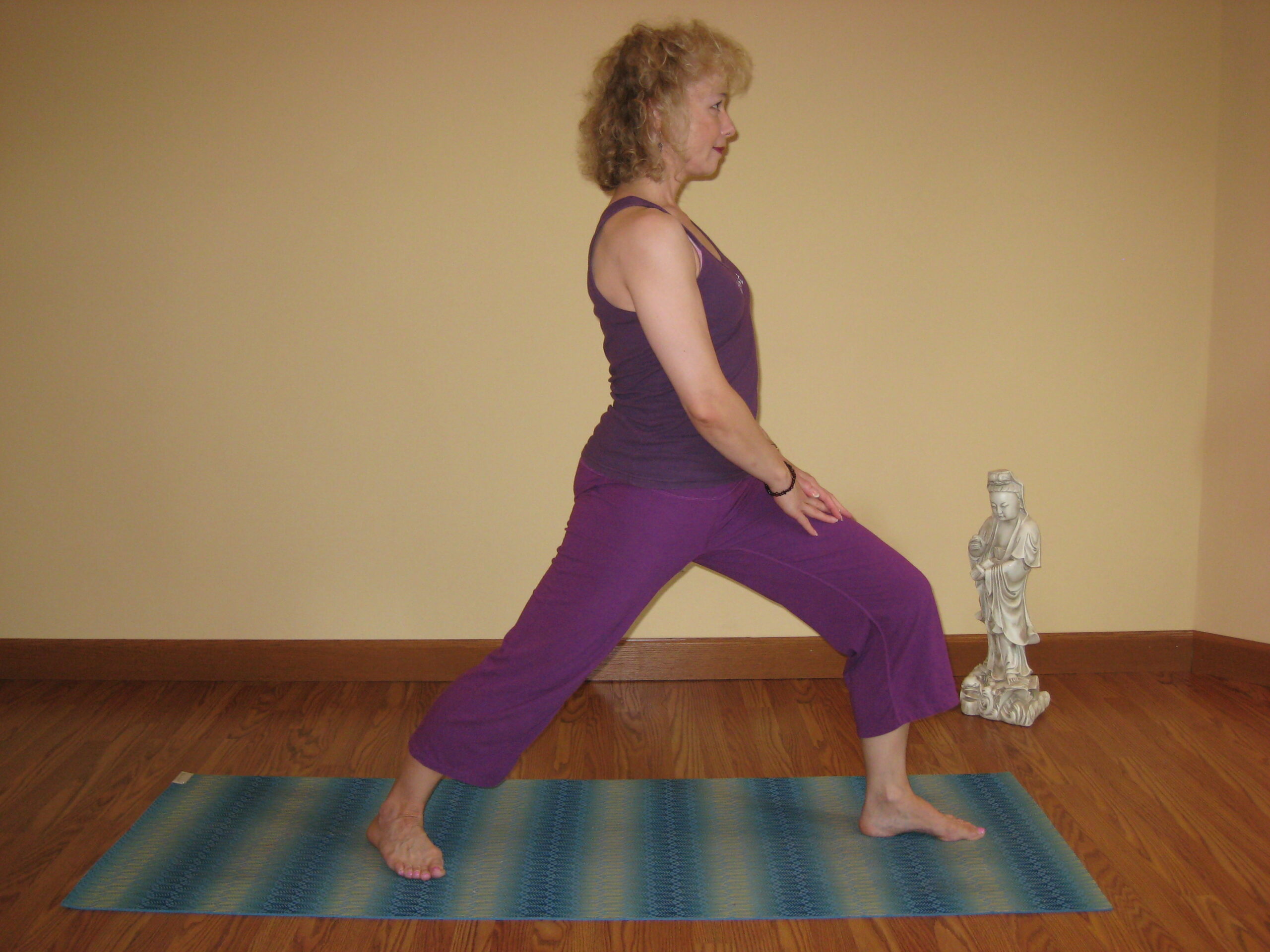
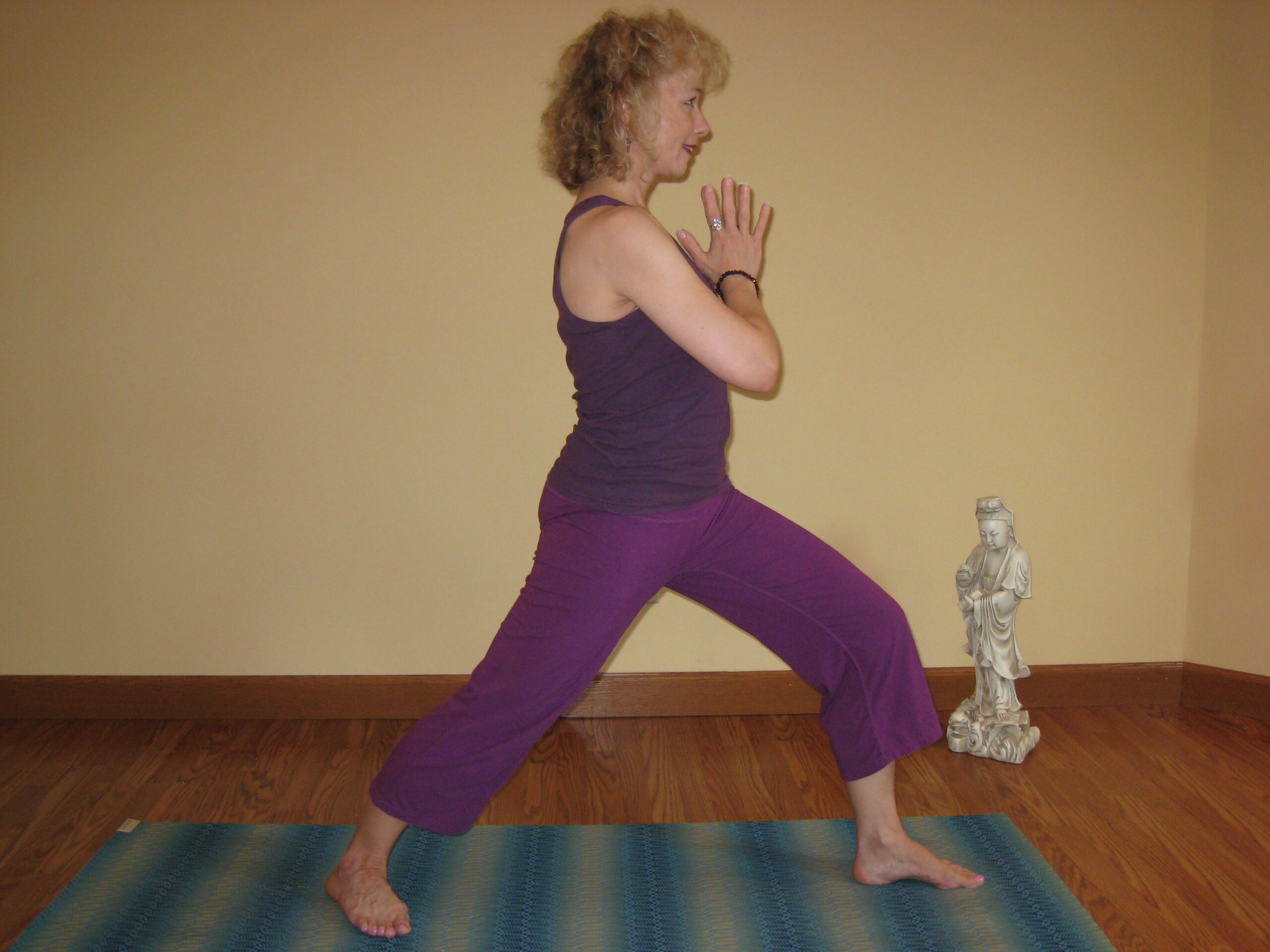
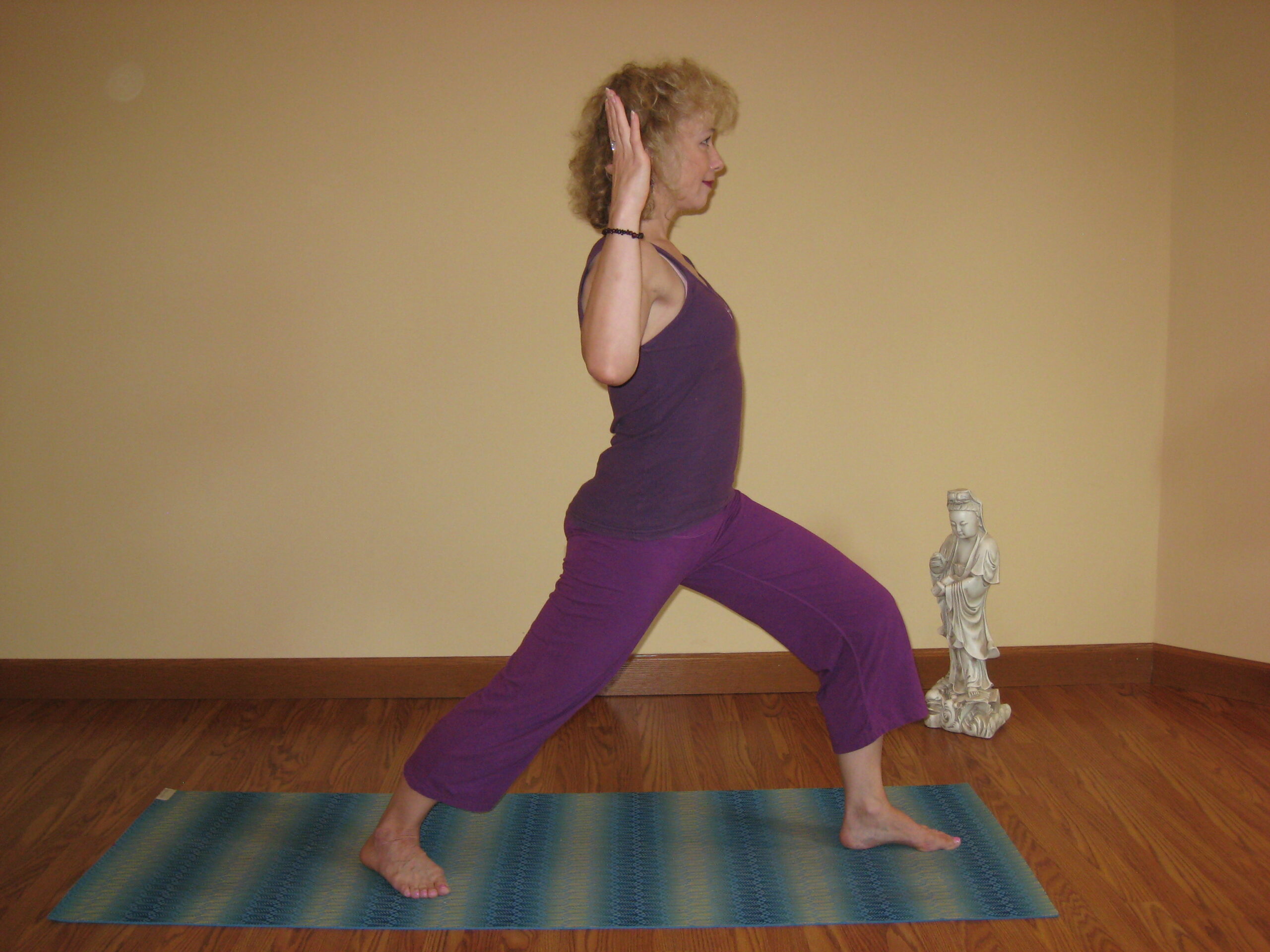
Legs: You can put less of a bend in the front leg or shorten your stance between the front and back leg to decrease the intensity of the pose, Photo #6.
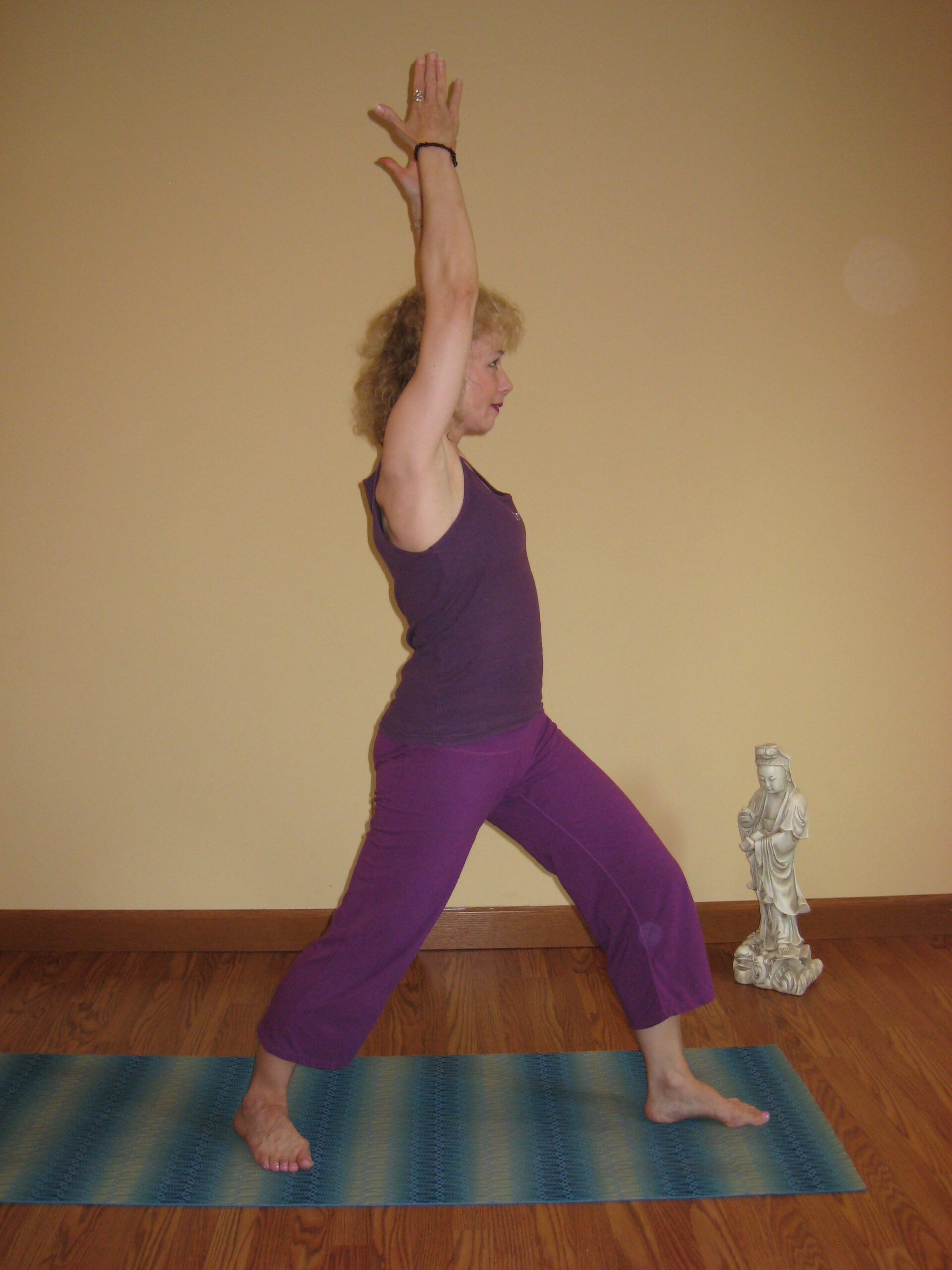
Tip: Beginners tend to tilt their pelvis forward. Make sure your tailbone floats down and your pubis bone lifts toward the naval as you sink into the pose. This keeps the pelvic girdle relatively parallel to the floor and the lower back elongated.
Advanced options: For more challenge, you can come into Warrior I from Down Dog by stepping your right foot forward into a lunge and using your core strength as well as the grounded front leg to lift the torso up to standing while raising your arms overhead to the sky.
Not ready to lift the upper torso from the ground just yet? You can try walking up the front leg with the hands bringing one hand to the knee and then the other Photo #7, regaining any lost balance, and then reaching the arms to the sky!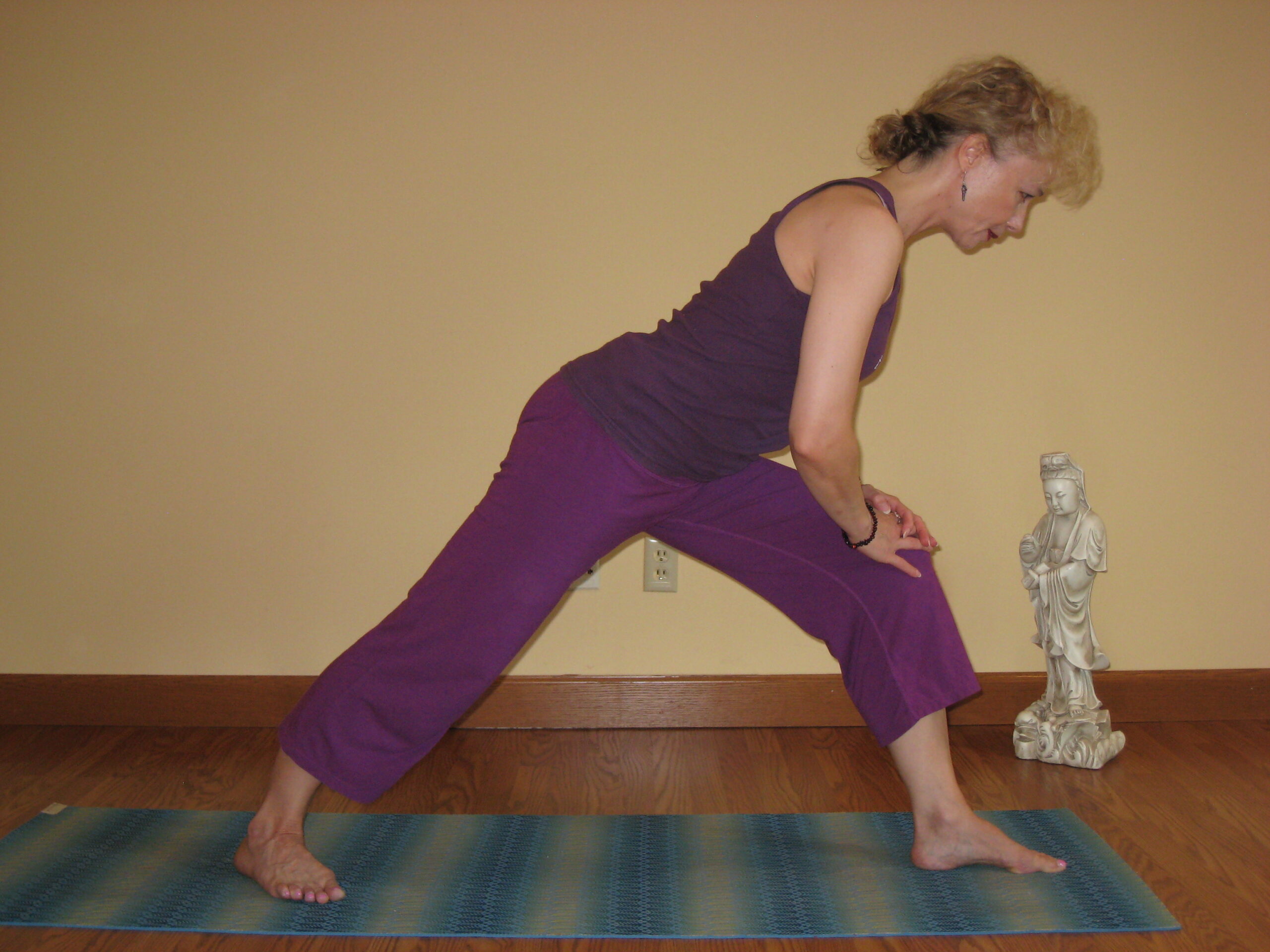
Adding movement to a Warrior I amps up the volume on building muscle! Let’s try a few of these options:
Yoga Mudra arms: Once in the pose, clasp the fleshy palms of your hands together behind your back and lift up the arms, opening the heart center, Photo #8. If your shoulders are tight, and the hands don’t connect to the palms, you can hold a strap between your hands. See below for a version of this pose that takes it one step more—Waterfall Warrior.
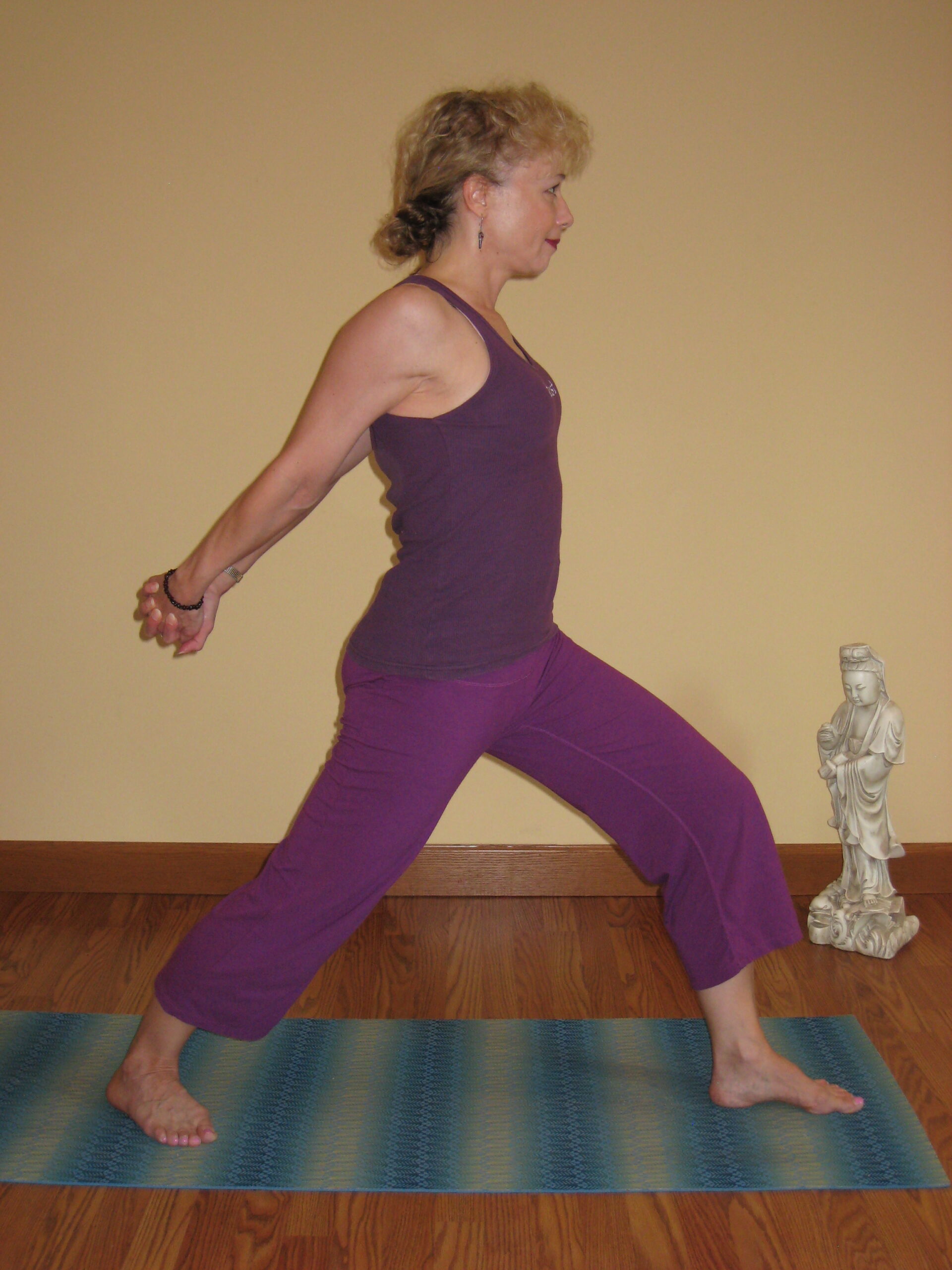
Humble Warrior flow as well as holding humble warrior and adding arm rotations up and back: I use Humble Warrior, Photo #9, as an option when I’m teaching Waterfall Warrior below. You bring your hands to heart center in the Namasté position and hinge at the hip engaging your abdominals as you lean forward slightly toward the front, bent knee. Inhale up, exhale down for a flow.
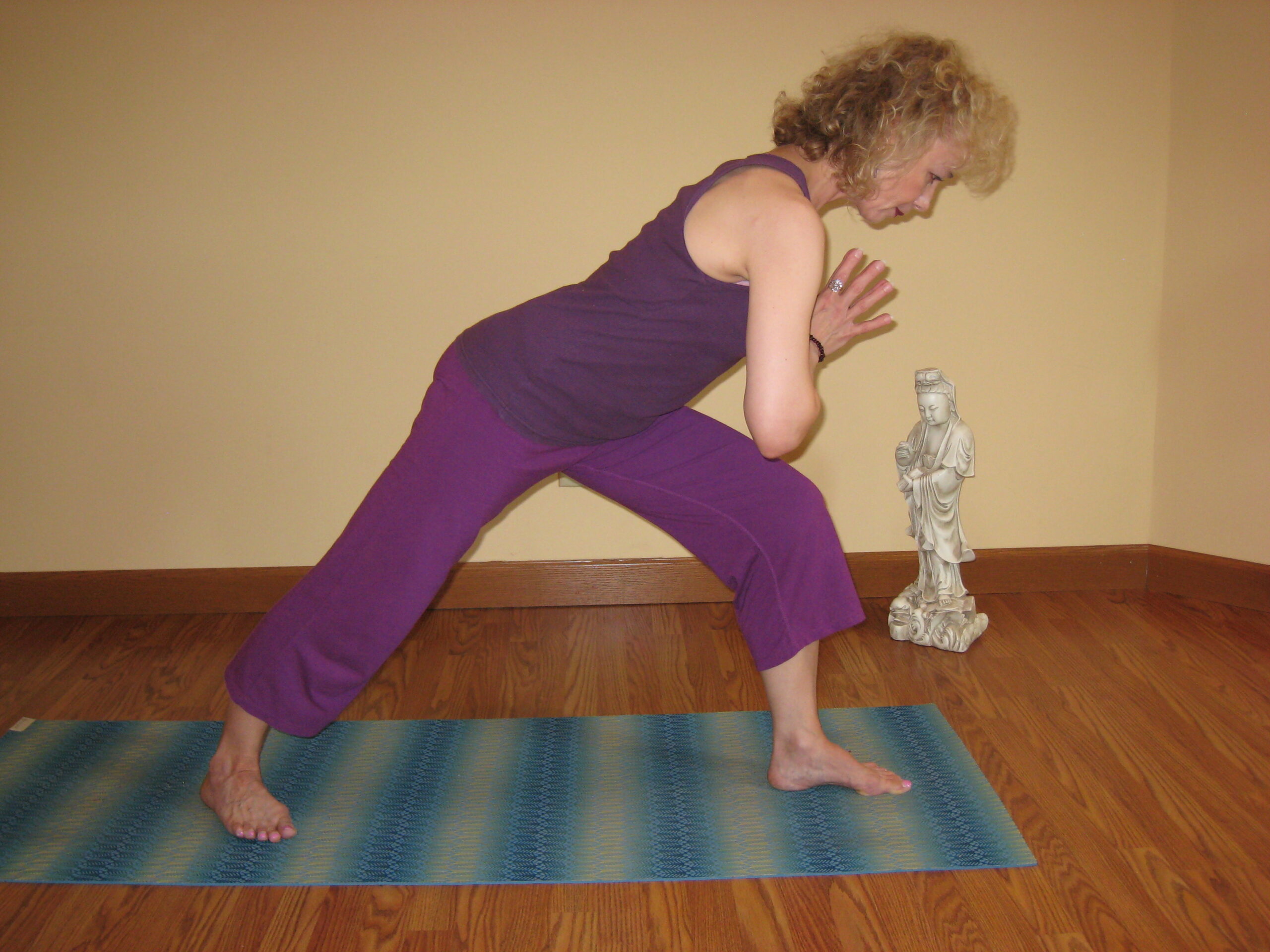
Humble Warrior hold with arm rotations up and back: Holding the Humble Warrior base, as described above, inhale the arms up to the sky, palms facing the sky, Photo #10. Then exhale as you rotate the palms down and swing the arms up behind you reaching the arms back so that the palms again face the sky, Photo #11.
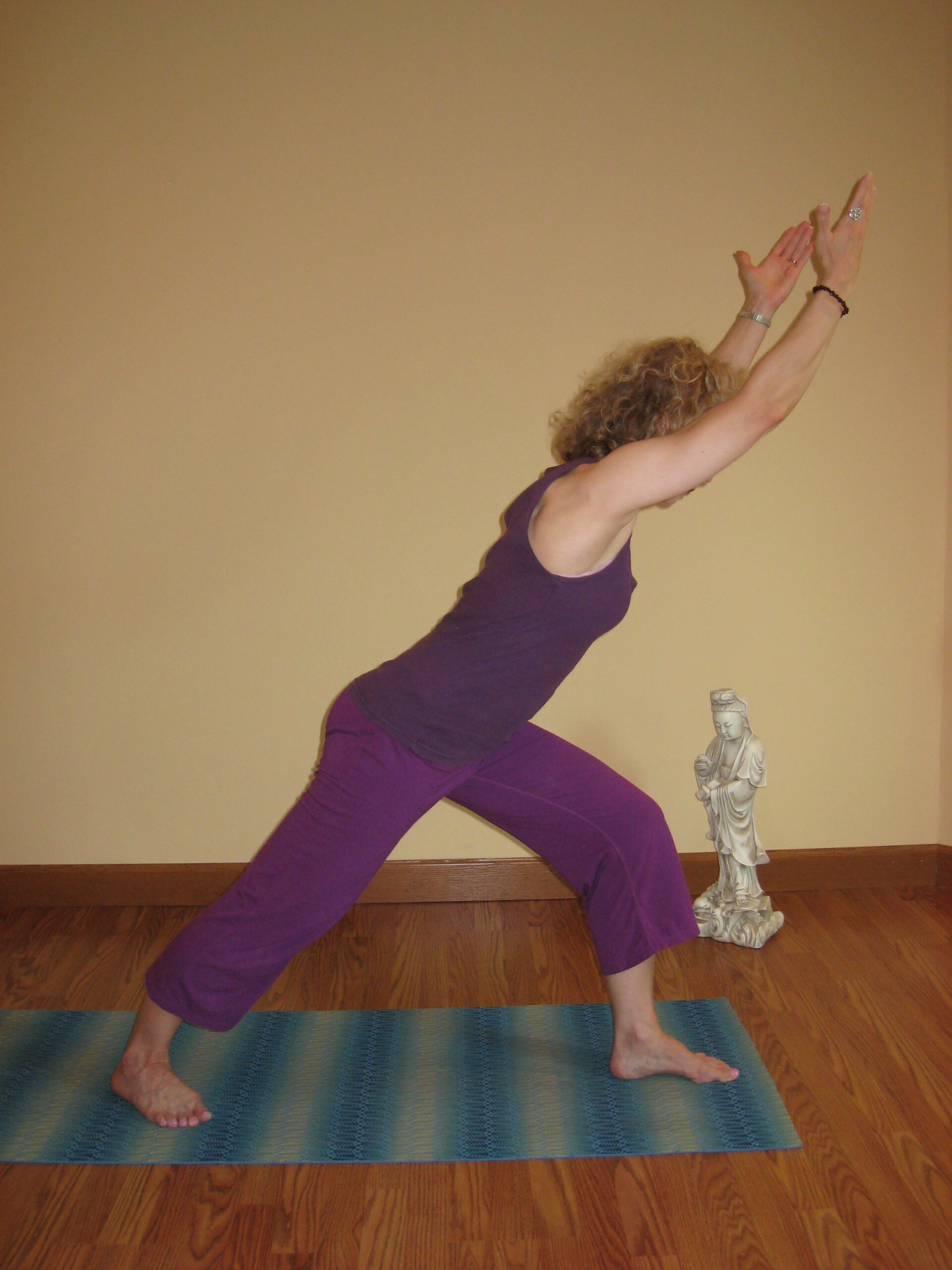
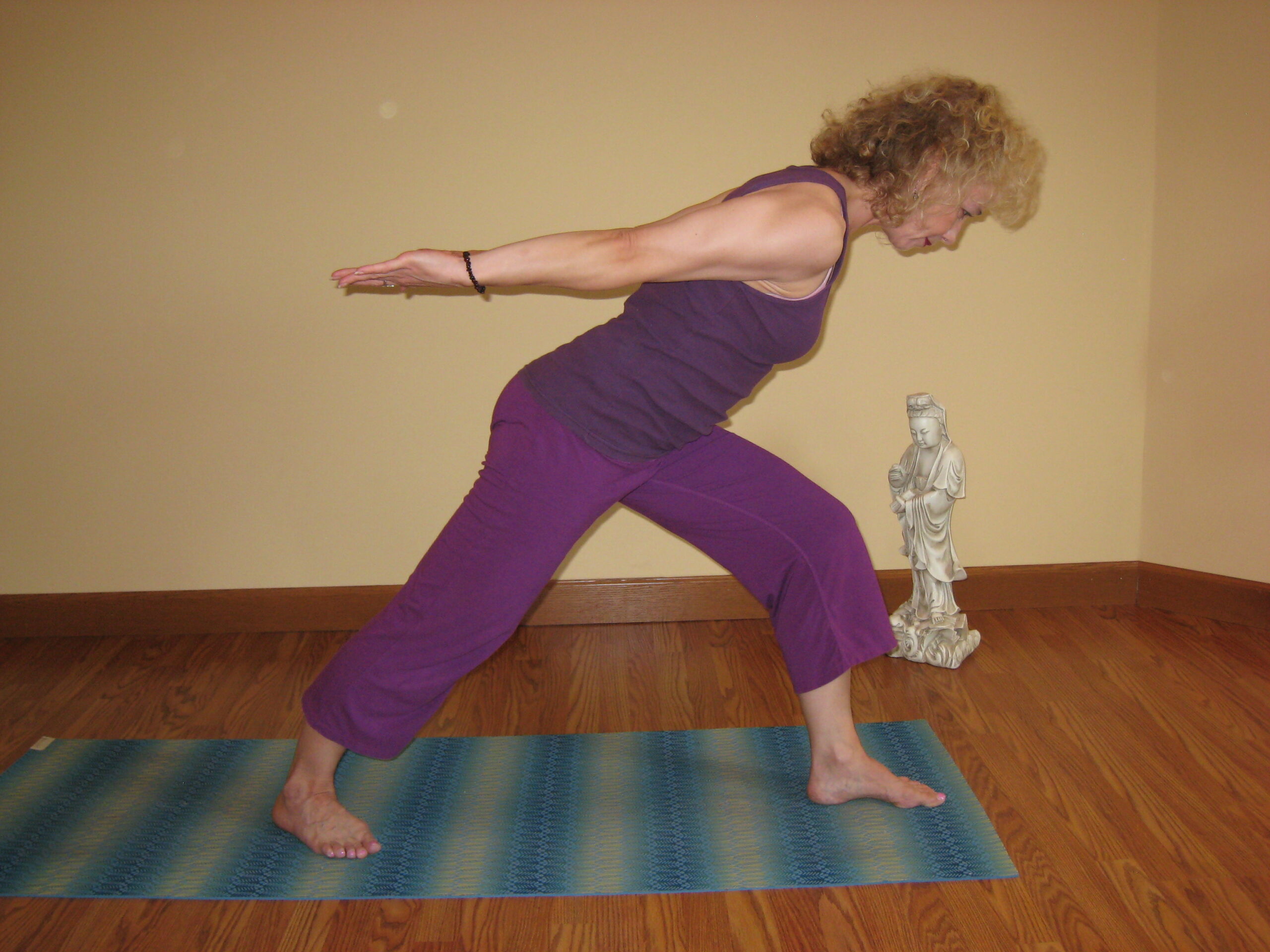
Waterfall Warrior flow: Clasp your fleshy palms together behind your back in Yoga Mudra, as described above. Engage your abdominals as you flow exhaling down and inhaling up waving your spine as in Cow/Cat pose, respectively. As you exhale down, your spine waves into a “Cow”—baby backbend pose as you aim toward the inside of the front, bent knee, Photo #12. As you inhale up, your spine waves into a “Cat” pose, arching the back toward the sky, Photo #13. The power of your activated core drives this pose keeping your low back protected. The distance you go toward the front bent knee on the down flow is totally dependent upon your individual level of both comfort and flexibility. You can end on the down flow and go deeper toward the ground flowing into a “runner’s” low lunge and on from there to your next pose; or end on the up flow—Yogi’s choice.
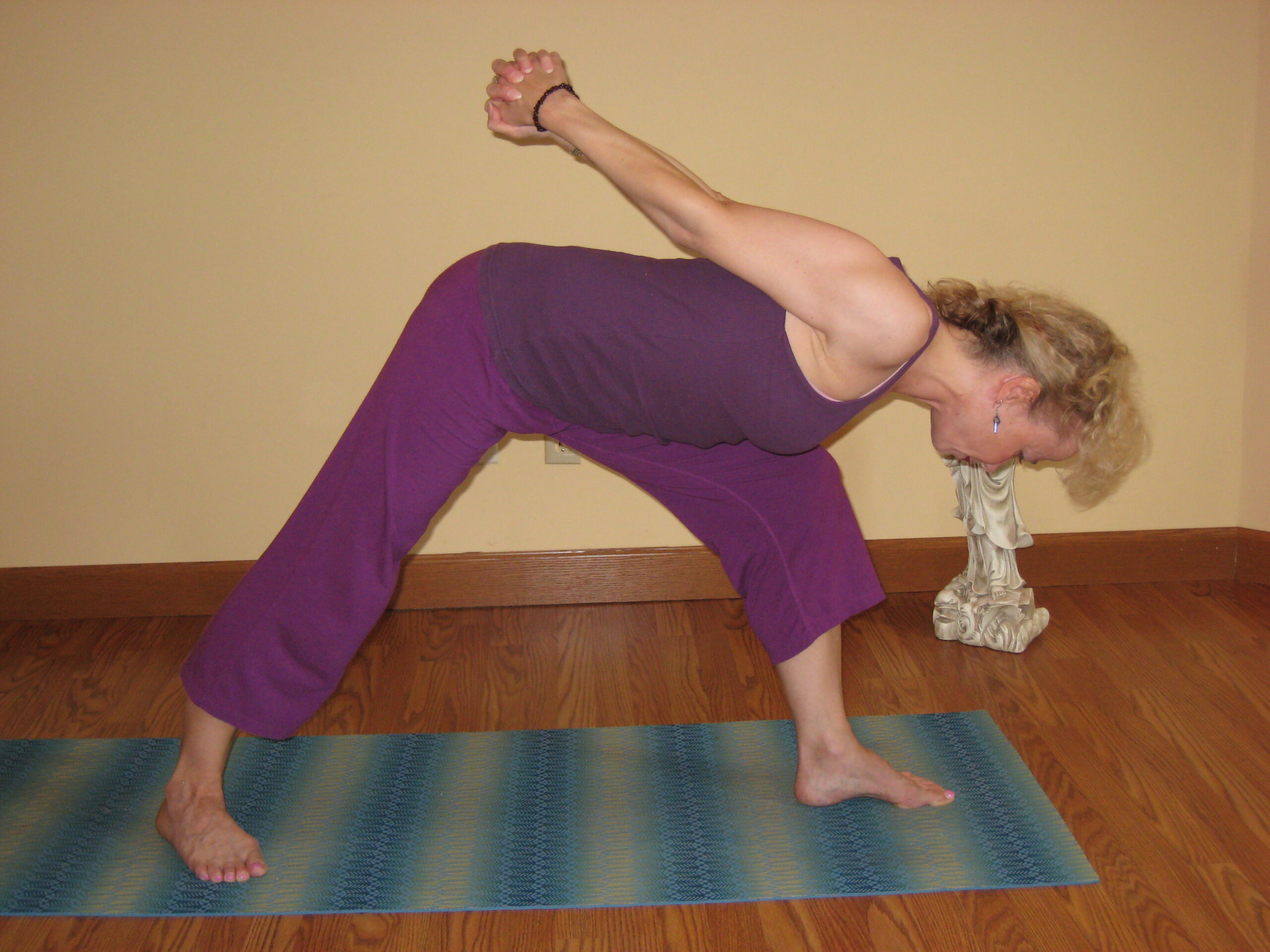
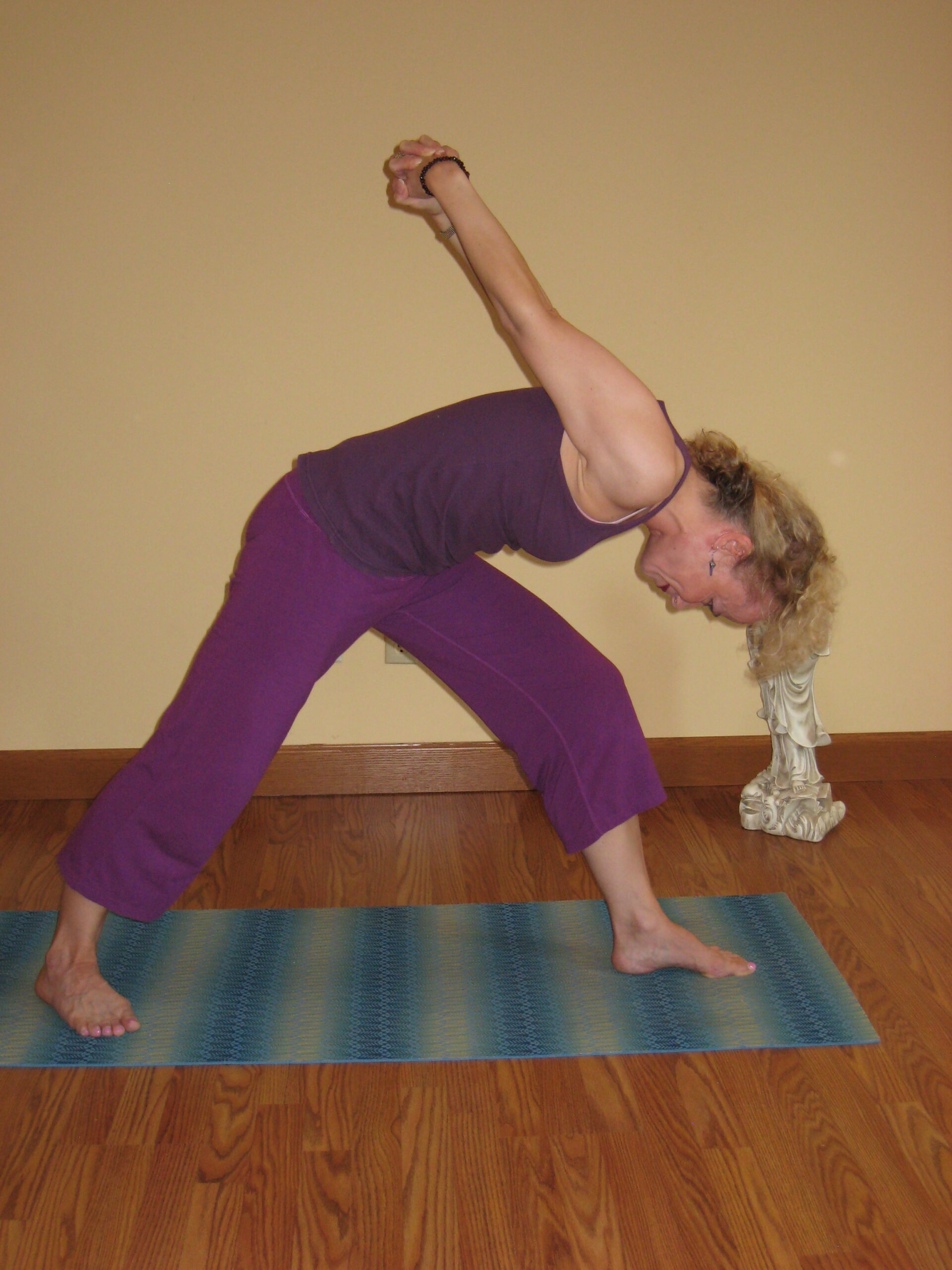
Yoga Mudra coupled with the forward fold motion described here loosens the shoulders, arms, and spinal column, and improves posture and back problems. I first learned of this flow from Sadie Nardini. I’ve also seen it referred to as the “Silver Surfer” on the Power to the Peaceful Yoga DVD by Jivamukti Yoga co-founders, Sharon Gannon and David Life. The Vinyasa clip from Power to the Peaceful Yoga that I saw was actually a bonus clip on Sharon ’s excellent DVD, Chakra Balancing Yoga.
Cactus arm flow: I’d already mentioned using cactus arms as an option if your shoulders don’t have the range of motion to bring the elbows in line with the ears when you raise your arms to the sky. Cactus flow is a nice addition to add to a Warrior I flow. When I use Cactus arms in a flow, I exhale the front leg straight and drop the arms down to the side, Photo #14, and inhale the arms into Cactus arms as you bend the front knee again, Photo #5. Option: Pull the hands behind the shoulders/ears to work with those that have an overly emphasized thoracic curve, or simply to open the chest more and unfurl those curled shoulders, Photo #15. This flow as well as the Viniyoga flow below was introduced to me in the books referenced below. Sometimes I inhale the arms to the sky, as in classic Warrior I, while straightening the front leg and exhale into Cactus arms…this is my own version of that flow that works for me too.
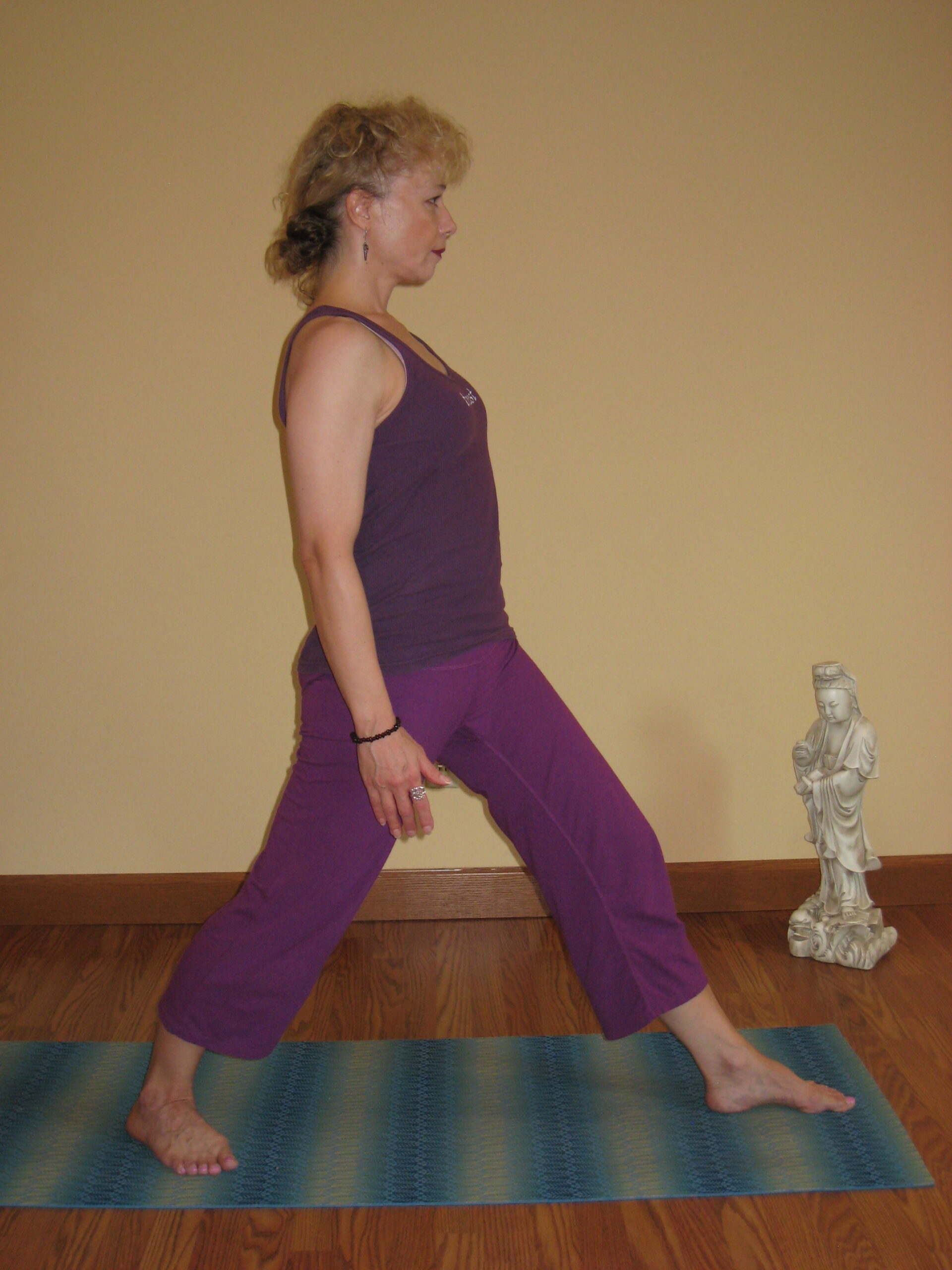
Viniyoga Warrior I flow: Gary Kraftsow’s Viniyogatherapy for the low back, sacrum and hips DVD as well his Yoga for Transformation and Yoga for Wellness books, introduced me to this flow. In Warrior I, as you inhale rest the left hand on the left thigh, and lift the right arm to the sky as you bend the left knee. The lifted right arm comes back even beyond the right ear a bit emphasizing the Psoas muscle stretch along the right side of the body, Photo #16 (I could have gone a bit further than pictured!). Exhale as you straighten the bent leg and bring the raised arm down, Photo #17. A tight Psoas muscle can be the cause of back pain—so I love this flow, and all of Gary Kraftsow’s work!

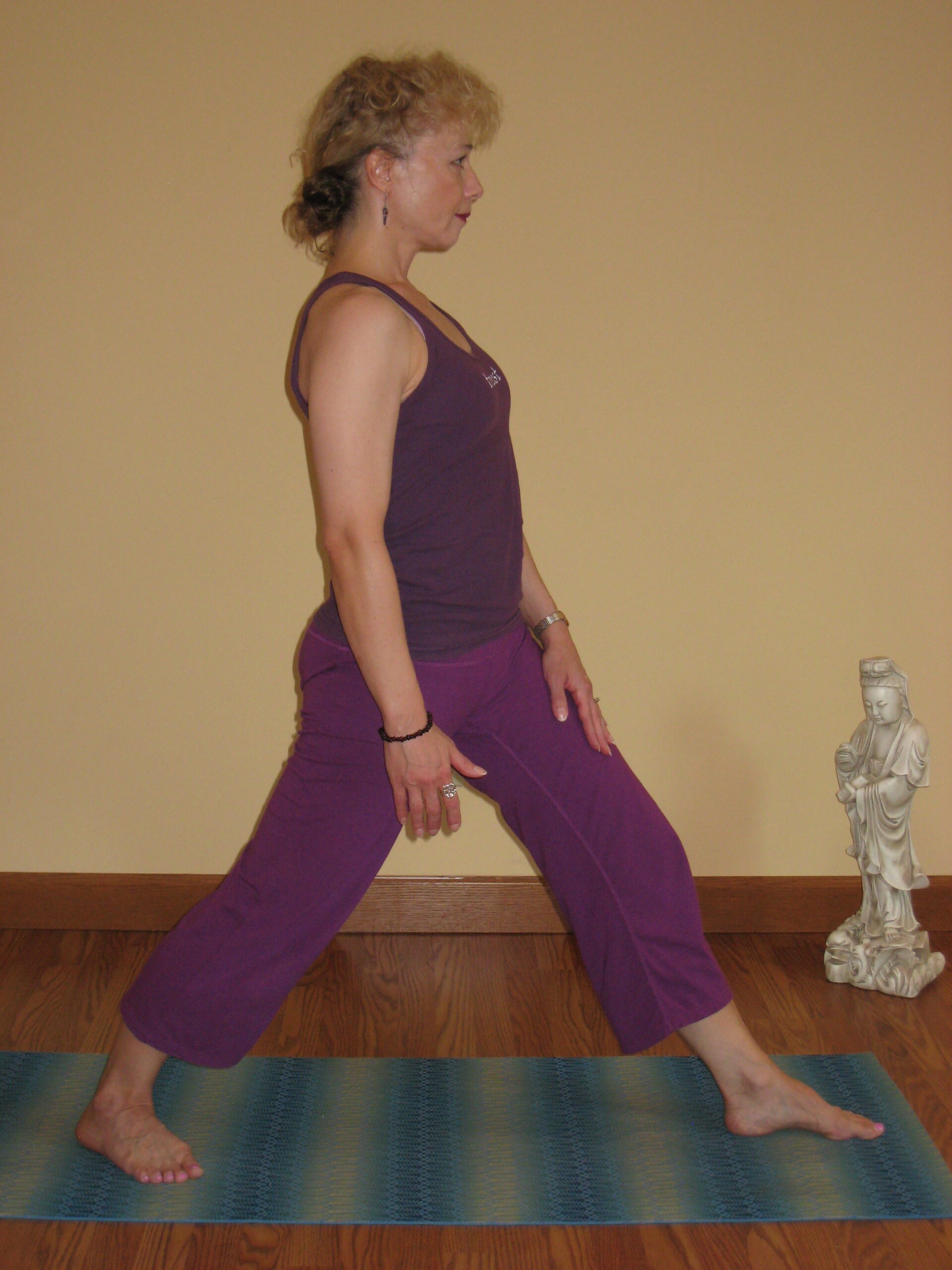
There are many other arm holds without a flow that we can incorporate with Warrior I, such as cow-face arms (which I’ll cover another day!); and, alternatively, simply holding the elbow with the opposite hands behind the back, (not pictured).
Contraindicated for:
- Recent or chronic injury to the hips, knees, back or shoulders.
- Those with high blood pressure or other cardiac condition
- Those with low blood pressure should bring the hands to heart center or rest them on the front thigh
- Yoga Fit® recommends omitting Warrior I from a prenatal class using a Crescent Moon option instead.
